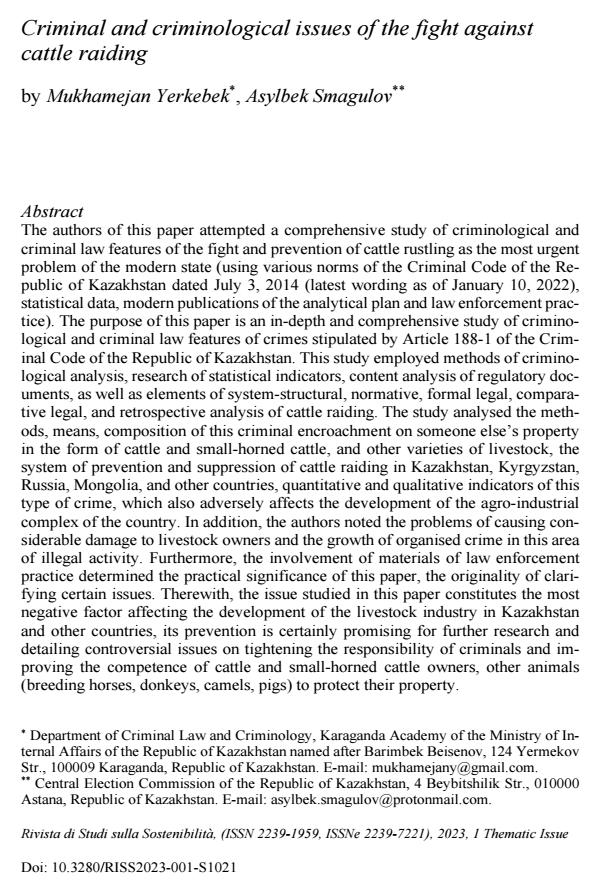Criminal and criminological issues of the fight against cattle raiding
Journal title RIVISTA DI STUDI SULLA SOSTENIBILITA'
Author/s Mukhamejan Yerkebek, Asylbek Smagulov
Publishing Year 2023 Issue 2023/1 T.
Language English Pages 16 P. 331-346 File size 135 KB
DOI 10.3280/RISS2023-001-S1021
DOI is like a bar code for intellectual property: to have more infomation
click here
Below, you can see the article first page
If you want to buy this article in PDF format, you can do it, following the instructions to buy download credits

FrancoAngeli is member of Publishers International Linking Association, Inc (PILA), a not-for-profit association which run the CrossRef service enabling links to and from online scholarly content.
The authors of this paper attempted a comprehensive study of criminological and criminal law features of the fight and prevention of cattle rustling as the most urgent problem of the modern state (using various norms of the Criminal Code of the Re- public of Kazakhstan dated July 3, 2014 (latest wording as of January 10, 2022), statistical data, modern publications of the analytical plan and law enforcement prac- tice). The purpose of this paper is an in-depth and comprehensive study of crimino- logical and criminal law features of crimes stipulated by Article 188-1 of the Crim- inal Code of the Republic of Kazakhstan. This study employed methods of crimino- logical analysis, research of statistical indicators, content analysis of regulatory doc- uments, as well as elements of system-structural, normative, formal legal, compara- tive legal, and retrospective analysis of cattle raiding. The study analysed the meth- ods, means, composition of this criminal encroachment on someone else’s property in the form of cattle and small-horned cattle, and other varieties of livestock, the system of prevention and suppression of cattle raiding in Kazakhstan, Kyrgyzstan, Russia, Mongolia, and other countries, quantitative and qualitative indicators of this type of crime, which also adversely affects the development of the agro-industrial complex of the country. In addition, the authors noted the problems of causing con- siderable damage to livestock owners and the growth of organised crime in this area of illegal activity. Furthermore, the involvement of materials of law enforcement practice determined the practical significance of this paper, the originality of clari- fying certain issues. Therewith, the issue studied in this paper constitutes the most negative factor affecting the development of the livestock industry in Kazakhstan and other countries, its prevention is certainly promising for further research and detailing controversial issues on tightening the responsibility of criminals and improving the competence of cattle and small-horned cattle owners, other animals (breeding horses, donkeys, camels, pigs) to protect their property. Key words: cattle raiding, theft, civil law, cattle and small-horned cattle, method of commission, animal husbandry.
Mukhamejan Yerkebek, Asylbek Smagulov, Criminal and criminological issues of the fight against cattle raiding in "RIVISTA DI STUDI SULLA SOSTENIBILITA'" 1 T./2023, pp 331-346, DOI: 10.3280/RISS2023-001-S1021